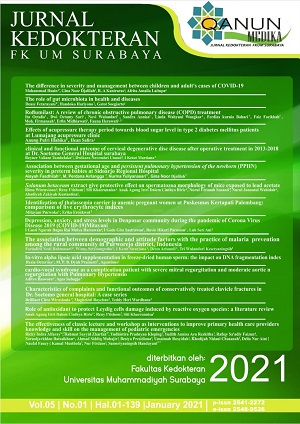Role of antioxidant to protect Leydig cells induced by reactive oxygen species: a literature review
Abstract
The Leydig cells play crucial role in steroidogenesis and spermatogenesis. Those processes need complex communication in hormonal and testicular to maintain male reproductive function. Abnormal condition induced by reactive oxygen species reduce cell viability through lipid peroxidation and apoptotic pathway. Antioxidant ameliorate ROS elevation and prevent cell damage. Specifically, Leydig cells are vulnerable to ROS exposure and decline its function in mediating spermatogenesis. Therefore, it is needed to improve Leydig cells viability within antioxidant supplementation. This study aimed to determine the protective effect of antioxidant on Leydig cells induced by reactive oxygen species. This type of study is a literature review. Various studies have been reviewed through critical appraisal tool Olsen-Baisch Scoring for integrated review. Furthermore, this study highlighted the importance of the mechanism of antioxidant as protective agent of Leydig cells. Supplementation of antioxidant with the correct administration, dosage, and duration is potential to balance reactive oxygen species level and protect Leydig cells. Â
 Keywords            : Leydig cell, antioxidant, reactive oxygen species, infertility
Full text article
References
Ali RI and Ibrahim MA. (2018). Malathion induced testicular toxicity and oxidative damage in male mice: the protective effect of curcumin. Egyptian J Forensic Sci, 8 (70), 1-13.
Asadi N et al. (2017). The impact of oxidative stress on testicular function and the role of antioxidants in improving it: a review. J Clin Diagnostic Res, 11 (5), 1-5.
BaSalamah MA et al. (2018). Vitamin D alleviates lead induced renal and testicular injuries by immunomodulatory and antioxidant mechanisms in rats. Scientific Reports, 8 (4853), 1-13.
Bihst S et al. (2017). Oxidative stress and male infertility. Nat Rev Urol, 14 (8), 470-485.
Darbandi M et al. (2018). Reactive oxygen species and male reproductive hormones. Rep Biol Endocrin, 16 (1), 1-14.
Eleiwa NZH et al. (2018). Antioxidant activity of Spirulina platensis alleviates doxorubicin‑induced oxidative stress and reprotoxicity in male rats. Oriental Pharm Exp Med, 18, 87-95.
El-Maddawy ZK and El-Sayed YS. (2018). Comparative analysis of the protective effects of curcumin and N-acetyl cysteine against paracetamol-induced hepatic, renal, and testicular toxicity in Wistar rats. Environ Sci Pollut Res, 25, 3468-3479.
Erboga M et al. (2015). Anti-apoptotic and anti-oxidant effects of caffeic acid phenethyl ester on cadmium-induced testicular toxicity in rats. Biol Trace Elem Res, 171 (1), 176-184.
Hamzeh M et al. (2019). Cerium oxide nanoparticles protect Cyclophosphamide‑induced testicular toxicity in mice. Int J Prev Med, 10 (5), 1-9.
He L et al. (2017). Antioxidants maintain cellular redox homeostasis by elimination of reactive oxygen species. Cell Physiol Biochem, 44, 532-553.
Hu W et al. (2017). Adrenomedullin protects Leydig cells against lipopolysaccharide -induced oxidative stress and inflammatory reaction via MAPK/ NF-κB signalling pathways. Scientific Reports, 7 (16479), 1-15.
Khushboo M et al. (2018). Testicular toxicity and sperm quality following copper exposure in Wistar albino rats: ameliorative potentials of L-carnitine. Environ Sci pollut Res, 25, 1837-1862.
Ko EY et al. (2014). Male infertility testing: reactive oxygen species and antioxidant capacity. Fertility & Sterility, 102 (6), 1518-1527.
Kong ZL et al. (2018). Effect of Cistanche Tubulosa extracts on male reproductive function in streptozotocin–nicotinamide-induced diabetic rats. Nutrients, 10, 1-22.
Kumar ST and Neeraja P. (2019). Factors associated with oxidative stress in the testes and the mitigating role of antioxidants: a review. Int J Rec Innov Med Clin Res, 1 (1), 6-12.
Kurutas EB. (2016). The importance of antioxidants which play the role in cellular response against oxidative/nitrosative stress: current state. Nutrition J, 15 (1), 1-22.
Moneim AEA. (2016). Prevention of carbon tetrachloride (CCl4)-induced toxicity in testes of rats treated with Physalis peruviana L. fruit. Toxicol Industrial Health, 32 (6), 1064-1073.
Mosbah R et al. (2016). Protective role of Nigella sativa oil against reproductive toxicity, hormonal alterations, and oxidative damage induced by chlorpyrifos in male rats. Toxicol Industrial Health, 32 (7), 1266-1277.
Ok S, Kang JS, and Kim KM. (2016). Testicular antioxidant mechanism of cultivated wild ginseng extracts. Mol Cell Toxicol, 12, 149-158.
Rawi SM and Nassr FMSA. (2015). Zinc sulphate and vitamin E alleviate reproductive toxicity caused by aluminium sulphate in male albino rats. Toxicol Industrial Health, 31 (3), 221-234.
Redza-Dutordoir M and Averill-Bates DA. (2016). Activation of apoptosis signaling pathways by reactive oxygen species. Biochimica et Biophysica Acta, 1863, 2977-2992.
Sadeghzadeh F, Mehranjani MS, and Mahmoodi M. (2019). Vitamin C ameliorates the adverse effects of dexamethasone on sperm motility, testosterone level, and spermatogenesis indexes in mice. Hum Exp Toxicol, 38 (4), 409-418.
Schaalan MF, Ramadan BK, and Elwahab AHA. (2018). Ameliorative effect of taurine-chloramine in azathioprine-induced testicular damage; a deeper insight into the mechanism of protection. BMC Complement Alternative Med, 18, 1-14.
Wagner H, Cheng JW, and Ko EY. (2018). Role of reactive oxygen species in male infertility: an updated review of literature. Arab J Urol, 16 (1), 35-43.
Yousaf B et al. (2016). Bisphenol A exposure and healing effects of Adiantum capillus-veneris L. plant extract (APE) in bisphenol A-induced reproductive toxicity in albino rats. Environ Sci Pollut Res, 23, 11645-11657.
Yu Y et al. (2018). Ameliorative effect of VE, IGF-I, and hCG on the fluoride-induced testosterone release suppression in mice Leydig cells. Biol Trace Elem Res, 181 (1), 95-103.
Zhou J et al. (2019). The roles and mechanism of Leydig cells and myoid cells in regulating spermatogenesis. Cell Mol Life Sci, 76, 2681-2695.
Zirkin BR and Papadopoulos V. (2018). Leydig cells: formation, function, and regulation. Biol Rep, 99 (1), 101-111.
Authors

Qanun Medika by FK UM Surabaya is liscence under Lisensi Creative Commons Atribusi 4.0 Internasional.

